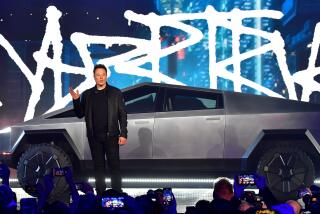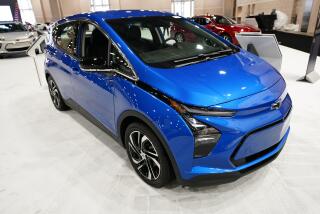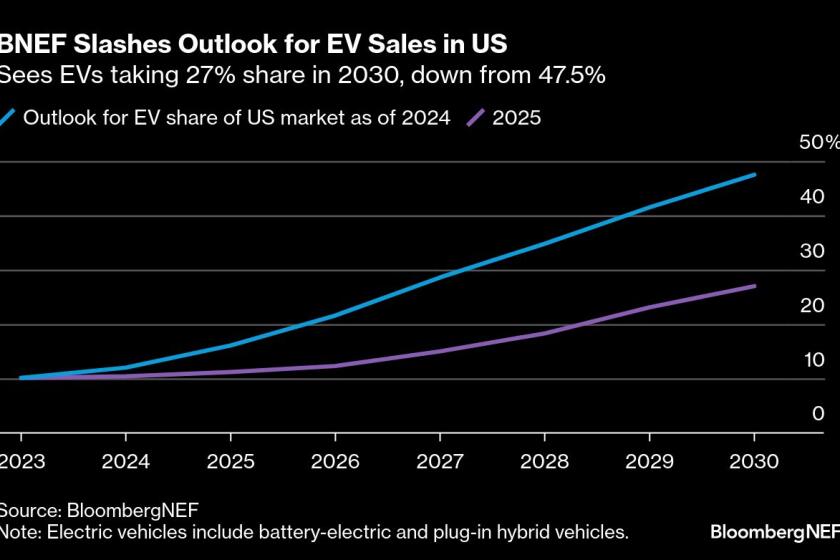2nd Generation of Electric Cars Put Through Battery of Cold Tests
- Share via
MIDDLESEX, Vt. — Tom Rawls forgot to fill the fuel tank under the hood of his Solectria car, so all he got out of his defroster on a recent blustery afternoon was a blast of cold air.
Lack of a fossil fuel didn’t keep Rawls from tooling around the roads of central Vermont, though. The battery pack in back took care of that--Rawls is driving one of the second generation of winter-ready electric vehicles being tested in Vermont.
The interior breeze from the defroster, although bracing, was effective for a short drive. “It’ll do,” Rawls said as he pulled out onto U.S. 2.
Rawls’ failure to put a couple of gallons of diesel or kerosene under the hood demonstrated one of the obstacles researchers found during their first winter putting the electric vehicles through their paces: the absence of a hot internal combustion engine makes it pretty hard to get the car warm, let alone to keep ice from forming on the inside of the windshield.
Hence the installation of a small heater, similar to models used to warm the sleeping cabins of long-distance trucks, that, ironically, relies on burning a natural resource and venting its exhaust into the atmosphere. That kind of pollution is one of the things electric cars are supposed to reduce.
“There’s just no other way to get heat,” said Joe Gagliano of M.J. Bradley Associates in Concord, Mass., a firm assisting with the research.
That’s something that test drivers learned last year during a winter that was much milder than even the first several weeks of this season have been.
“There were times, if you were starting at zero [degrees outdoor temperature], the cabin never got above 30 or 40 degrees,” said Richard Watts, director of the Vermont consortium of state government, electric utilities and private businesses testing the technology.
“We tried to address it,” he said, by putting experimental technology in a new generation of cars that hit the roads of Vermont, Quebec, New Hampshire and Massachusetts last week. “This is an emerging industry. It’s just work that needs to be done.”
Vermont has been at the center of research into the technology used in EVs and ZEVs, as electric vehicles and zero-emission vehicles are known in the trade.
Advocates are trying to make sure the vehicles have all the conveniences and comforts of a typical gasoline-fired car so they’ll gain consumer acceptance.
But the weather is one of the primary factors that can dramatically affect the vehicles’ performance. So the military, which is interested in one day putting electric vehicles into battlefield fleets, has been sponsoring research projects through the Northeast Alternative Vehicle Consortium.
*
The Vermont project won a $300,000 grant last year through the consortium and the military to test the electric technology. This year $2 million is being spent and next year’s goal is for at least another $1 million.
Some cars being tested this winter will be sent to Georgia during the summer to test air-conditioning and to determine how their wintertime improvements affect summertime performance.
Between now and then, they will be put through a battery of tests. The steering wheels on some, for example, are being outfitted with a material developed for the space shuttle that retains heat and presumably keeps the driver more comfortable.
Others were supplied with heated seats, such as those installed in some European cars. Other technologies being tested include: solar glass; redesigned ventilation; systems for recovering and recirculating heat and viscosity lubricants.
*
“Each of them is a rolling test bed,” Watts said of the cars. “It has a different configuration of technology.”
Many of the tests and technology in the new phase of research were developed as a result of last winter’s project.
“We learned a lot about them,” said Rawls, who works for Green Mountain Power Corp., one of the utilities participating in the project. For example, even if the batteries were fully charged but he did not leave them plugged in overnight, they held their charge for much shorter distances, he said.
But knowing and understanding some of those limitations is one of the important factors in building acceptance for the vehicles, Rawls said. They are not designed for cross-country excursions but are perfect for commuting, even in the rugged hills and bitter cold of a Vermont winter, he said.
And the new technology also has some advantages over a typical Ford or Chevy, Gagliano said. Those heaters, for example. “It heats up much quicker than your internal combustion engine,” Gagliano said.
That is, if you fill the fuel tank.






